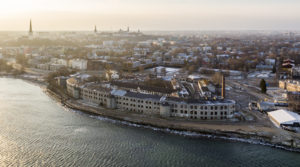According to Sergei Metlev, the Public and Partner Relations Manager of the Estonian Institute of Historical Memory, Estonia’s next major project, the Patarei Museum for the Victims of Communism embodies the country’s international mission of standing up for liberty.

The former Patarei prison, one of the most impressive historical buildings in the Baltic Sea region, stands on the brink of change. The complex, a symbol in the Estonians’ memory, awaits renovation. Thanks to Estonian entrepreneur Urmas Sõõrumaa, it is now possible to preserve the building, open the area to the public, provide various services, etc. In April 2018, many discussions took place concerning the building’s past and future. After much consideration, the state decided to establish an international museum for the victims of communism in the east wing of Patarei after the sale of the complex. A respective clause was added to the sales contract’s terms. The museum is one of the most substantial historic-cultural structures of recent years in Estonia.
What is the significance of the museum for Estonia and the world?
A nation needs a state to maintain and develop security, economic welfare and many other crucial elements. Undoubtedly a state is also necessary to create something permanent and distinguished for people both in and outside of the country in question. With major national projects we position ourselves among societies that wish to contribute to the acknowledgement of important values. Such communities are aware of their role, both in the past and the future. Patarei museum is our next grand project, a dignified undertaking dedicated to our century-old republic and an embodiment of Estonia’s international mission of standing up for liberty.
Establishing a museum in a former repressive institution helps to fill the blanks in knowledge regarding communist crimes in the world. The estimate for the total number of people killed by communist dictatorships is at 90 million. Only some countries have condemned communist regimes, but it is yet to be denounced internationally. Thus far, the pursuit to set up an international trial recognised by states, to investigate communist crimes, has not been a success. On the one hand, the reason for this is a catastrophic lack of knowledge. On the other, the absence of international condemnation supports the continuing unawareness and encourages those who justify communist crimes.
The museum contributes to global education, deters totalitarian ideologies and shares Estonia’s experience of recent history. One must not forget that totalitarianism endangers liberties and human dignity. Despite its occasional reappearance, its access to power can be prevented. Forgetting or romanticising the experience of violent communist experiments preconditions hard times to recur. The resurgence of totalitarian regimes is avoidable with efficient educational work and research.
The content of the museum and its connection with the Memorial to the Victims of Communism
Estonia’s Memorial to the Victims of Communism in Maarjamäe opened in 2018. The commemoration corridor is heartbreaking – full of names, memories and grief. Contrarily, the Home Garden is full of life and hope, a place reminding us we live in a free Estonia.
Across Tallinn Bay stands a fort that bears a dark memory for the Estonians. Many Estonians started their journey from there to the unknown in the summer of 1940. The Memento Association has published almost 10 000 names of those arrested on political grounds by Soviet security services in 1940-1941. The majority of those people were confined in the walls of Patarei for a shorter or a longer time. Most of the victims were killed, many perished in Russian prison camps later. During the German occupation and the second Soviet occupation, more innocent people in the thousands became victims of Patarei. Over 4000 political prisoners were jailed in 1945 alone. Therefore, Patarei extraordinarily sums up the ordeals and suffering of three occupations.
The commemoration museum of the victims of communism in Patarei is a well-needed and emotionally charged continuation of the memorial. Several streams of memory flow from the two symbolic sites in Tallinn and confluence with similar stories in other countries, such as the tragedy of the Polish people in Katyn, Stalin’s purges that killed millions of people living under USSR’s control or the extermination of nearly 2 million people in Cambodia by the Khmer Rouge.
There is not yet an educational and research institution in the world that focuses on the crimes of communist regimes as a whole, joining the streams to one river of memory. This “river” is not meant to feed the trauma forever. Rather, as Tõnu Lehtsaar, psychologist of the University of Tartu unerringly notes, a proper study of the trauma becomes the medicine: “The result is the understanding of life’s main values and finding an inner equilibrium”. Many nations need a place for putting their experiences in a bigger context to understand it deeply. Therefore, the museum initiative has many friends all over the world.
The International Museum for the Victims of Communism in Patarei gives a well-argued overview of how and on what conditions communism manifested itself through dehumanising totalitarian regimes that classified people based on their social standing. It also shows the criminal means by which the ideology aimed to achieve its goals and how it reflects in modern societies. For such an analysis, the doctrine itself as well as its forms of implementation must be dissected. Patarei’s authentic prison interior offers an extraordinary opportunity, whereas a building with no connection to repressions would hardly achieve the same effect. The future museum is based on modern historical research and various technical solutions, incorporating international partners.
The first stage of the museum is the exhibition area “Communism is Prison”, which opened last year. The Estonian Institute of Historical Memory is the creator of the current exhibition area and the developer of the future museum. In just 4,5 months, it welcomed over 36 000 visitors from over 30 countries, which clearly shows people’s desire to understand communism. The exhibition area will reopen after a winter break on 2 May 2020.
What does the museum mean for Patarei and for Tallinn?
After the collapse of the Soviet Union, the restored Estonian Republic was compelled to use Patarei as a prison until 2002. After its closure, the state repeatedly sought to sell the building. These efforts were fruitless until November 2019 when a company owned by Urmas Sõõrumaa finally bought Patarei.
Remarkably, Urmas Sõõrumaa used the word “environment” while explaining his plans for Patarei. It formed an entire military environment once, with its own pharmacy and bread factory. Later, it became a prison environment. In a new setting, Patarei can simultaneously be a popular place for business and pleasure as well as a historic and cultural monument, introducing a less romantic period of the building’s history.
Many have reacted with doubt to the idea of providing accommodation service in former prison cells. I have nothing against the entire building being in the service of culture. However, the only reason for concern is the neglect of the memory of thousands of Estonians and the crimes committed in Patarei. Fortunately, such carelessness is unseen at the moment. According to the terms of the sale, the museum must get its own space and the authentic interior must be preserved. Estonia supports the preparation of the museum through the Ministry of Justice, as the issues concerning repressed people and preserving their memory fall under the purview of the Ministry. Other parts of the building can serve different, appropriate objectives set by the owner.
It is important to understand that each era gives a new meaning to an old building, especially with a large scale development. The former churches of Europe are a great example. Many host libraries, government offices and provide accommodation services. A fine example in Tallinn is the industrial quarter of Rotermann, revived by Urmas Sõõrumaa. Looking west from Patarei, one can see Port Noblessner with its many cultural institutions and residential buildings. In the east, construction in Kalarand area has started. With the development of Noblessner, Patarei and the Seaplane Harbour, the Kalarand seafront will transform completely, perhaps claiming the title of the new centre and attracting thousands of tourists.
Such changes save valuable monuments from literal destruction, highlighting their historical legacy and linking them to modern needs and values. If all goes according to plan, Patarei’s new life will be deeply aware of its past while adapting to the present and looking to the future. These qualities are well-suited to a new grand monument, proving that Estonia has learned from its past and has plenty to share with the world.
Sergei Metlev
This article was originally published in Postimees on January 6, 2020.







